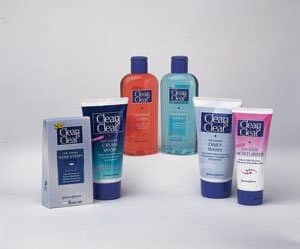
Johnson & Johnson (J&J) is well known in the United States and the UK for its Johnson’s Baby® brand. By the 1990s, the company realised that its expertise in babies’ skin might have credibility for other skin care products. Consequently, J&J decided to develop a series of sub-brands under the Johnson name, each targeted at different life stages.
This case study examines how J&J took an advertising campaign for the product Clean & Clear from the USA and transformed its concept to produce a positive effect in the UK market.
The first medicated skincare range J&J launched targeted female teenagers. This market consisted of treatment products that help to get rid of existing spots as well as preventative products. The range was launched under the Clean & Clear name, bought from Revlon in 1991. The vision was to make Clean & Clear ‘The global leader in female teen skincare’.
J&J targeted female teenagers because they:
- have spots
- use a lot of medicated products
- would grow up to be potential adult buyers of other J&J products.
Clean & Clear was launched in the UK in 1992, following its successful launch in the USA in 1991. In 1992, Clean & Clear was virtually unknown among teenagers. Therefore, this was effectively a completely new launch to the female teenage consumer. At the time the market was dominated by three brands as shown in Table 1. The three main products had been supported by considerable advertising spends during the 1980s.
Marketing objectives
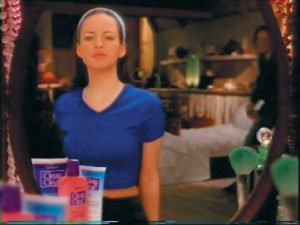
Marketing, like any other key business activity, requires direction provided by clear objectives. For Clean & Clear these were to:
- become the No. 1 medicated skincare brand by value
- become the most popular medicated brand amongst female teenagers
- establish a relationship with teenage girls that would lead to a loyalty to J&J for the rest of their lives.
This meant encouraging teenage girls to believe in an organisation that understood them and their needs.
Between 1993 and 1996, J&J in the UK adopted advertising that had been developed in the USA. ‘Girls Talking’ featured confident girls talking about how they didn’t worry about spots because they used Clean & Clear. The idea had emerged from the observation that teenage girls spend a lot of time talking about spots amongst themselves. Television advertising was supported by press advertising.
Failure to meet objectives
From the launch of Clean & Clear on the UK market until 1996, the product made significant gains in terms of value share. By the end of 1996 Clean & Clear had won 14 per cent of the market.
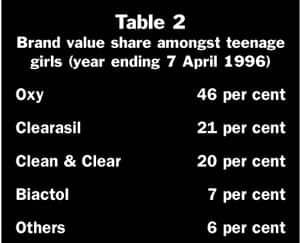
However, after five years Clean & Clear had not achieved its key objectives: it was not the No. 1 medicated brand and it was not the most popular brand amongst teenage girls. This suggested that it was not establishing the depth of relationship that it had anticipated.
The first warning sign was that the growth in sales appeared to be being generated by distribution gains rather than consumer demand. In other words, between 1992 and 1996 ten new Clean & Clear products were launched – while these were being bought by retail outlets the actual stockturn of the brand was slowing down. Stockturn measures the rate at which the total brand’s products are moving off the shelf. This is achieved by dividing total value sales by aggregate distribution.
Thus the increase in sales of Clean & Clear products was more as a result of increasing varieties being made available rather than substantial increases in demand for the individual products. In fact the sales of some of the more established products were actually declining.
The second major warning sign was that the future growth of the brand was being threatened by competitors becoming increasingly teen-girl targeted. Clean & Clear’s unique positioning was increasingly under threat – for example, in 1996 Oxy launched an Oxy Sensitive range. It was realised that there was a need to create growth through increases in stockturn rather than through distribution.
Promotion strategy

Research by J&J into customer perceptions revealed that some of the problem lay with the advertising. Advertising awareness is the extent to which potential consumers are able to identify the messages given out in advertisements and to identify the characteristics of a brand as they are put across in the advertisements. A survey of female spot product users in 1996 showed that Clean & Clear’s advertising awareness was low in comparison to competitors and the ratio between ad awareness and ad spend was lower than for competitors as shown in table 3.
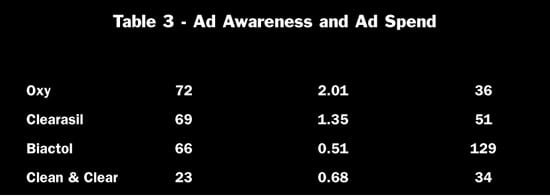
The advertising adopted from the United States, ‘Girls Talking’, was viewed negatively by British teenagers. It lacked impact among teenagers, didn’t help to generate empathy and led to small or very short term lifts in stockturn and sales.
‘Girls Talking’ worked in the USA, but the UK girls found the conversational style and content of the advertising to be artificial and patronising. It needed to be made ‘real’ for UK girls. A new creative brief was therefore developed focused on ‘getting real’. A brief is a summation of relevant instructions and facts.
With the help of video diaries (the result of giving video cameras to teenage girls over the Christmas period) the advertising agency was able to develop new scripts that incorporated shrewd insights from real conversations between UK teenage girls. Two scripts were chosen which worked very well in qualitative research. The chosen scripts were made into TV ads collectively known as ‘Real Girls’. One which teenage girls particularly identified with was known as ‘Big Bum’. (NB v/o = voice over).
1. How do they look? They make my bum look big don’t they?
2. What bum?
3. Come on, it sticks out a mile.
4. It’s a good job you don’t have spots to worry about as well – we’d be here all night.
5. v/o: Clean and Clear’s lotion is clinically tested to effectively remove everyday dirt and grease.
6. v/o: So no matter what, you’ll feel confident your skin is beautifully Clean & Clear.
7. So… how does this look?
8. Great!
9. Are you sure?
10.v/o: Clean & Clear and under control.
The media plan was designed to focus tightly on teenage girls’ favourite TV programmes such as The Big Breakfast. This tight targeting enabled Clean & Clear to talk to teenage girls for longer. In keeping with this tight targeting, the advertising agency spotted an unusual opportunity; a Boyzone concert in July 1997 where ‘Big Bum’ appeared on a giant screen in front of screaming fans.
Results
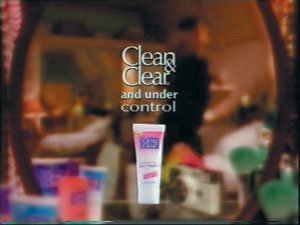
Immediately following the airing of ‘Big Bum’, Clean & Clear experienced the largest single increase in value share in an eight week period ever; equivalent to two years of the previous distribution-led growth.
By March 1999, Clean & Clear had met its objective of becoming the No. 1 brand in sales terms. Stockturn increased dramatically for practically all of the individual Clean & Clear products including:
- Clean & Clear Deep Cleansing Cream Wash
- Clean & Clear Exfoliating Daily Wash
- Clean & Clear Regular Lotion
- Clean & Clear Sensitive Lotion.
Clean & Clear became the most popular brand amongst female teenage buyers of medicated skincare, meeting its objective.
Evaluating the advertising campaign
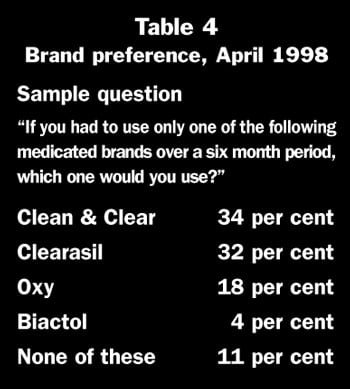
The evidence that the success of Clean & Clear in the late 1990s was affected by the new advertising campaign included the following:
- Increased advertising awareness (i.e. the extent to which consumers could associate the advertising with the brand) in absolute terms and in relation to other brands.
- Brand awareness also increased in the same period by 49%.
- Research into the views of teenage girls showed that, for the first time, girls were enthusing about Clean & Clear advertising, even laughing about how true it was to their lives and attitudes towards skincare.
- An econometric model, which takes account of the different factors that might affect sales growth, showed that without the ‘Real Girls’ advertising campaign, Clean & Clear’s rise in value share would have come to a hal.
A range of other factors can also be discounted as having led to the success of Clean & Clear in the late 1990s:
- No new products were launched and there were no product reformulations or changes in packaging
- There were no significant changes in factors relating to distribution
- There were no price cuts – in fact prices actually rose a little compared to the competition
- Advertising spend – relative to rivals – did not rise

Other factors, such as an increase in the population of teenage girls, an increase in the number of teenage girls suffering from spots or an increase in teenage girls’ disposable income, can also be eliminated – if they had been significant they would have affected the total medicated market.
Conclusion

Prior to the ‘Real Girls’ campaign, the brand was not on track to meet its objectives. By maintaining the theme of a global advertising idea but changing the UK advertising from translations of the US ads to ads based on genuine insights gained from local consumers, the situation was dramatically reversed.
The brand was able to become the No. 1 medicated skincare brand by value share. Johnson & Johnson is now rolling out the brand in 14 countries across Europe and the Middle East, doing so with advertising that recognises each country’s local needs.
 Skoda A3 ePoster Edition 13 "SWOT analysis in action at Skoda"
Skoda A3 ePoster Edition 13 "SWOT analysis in action at Skoda"  Roles & responsibilities (MP3)
Roles & responsibilities (MP3) 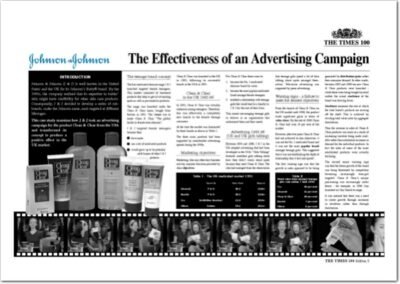 The effectiveness of an advertising campaign (PDF)
The effectiveness of an advertising campaign (PDF) 